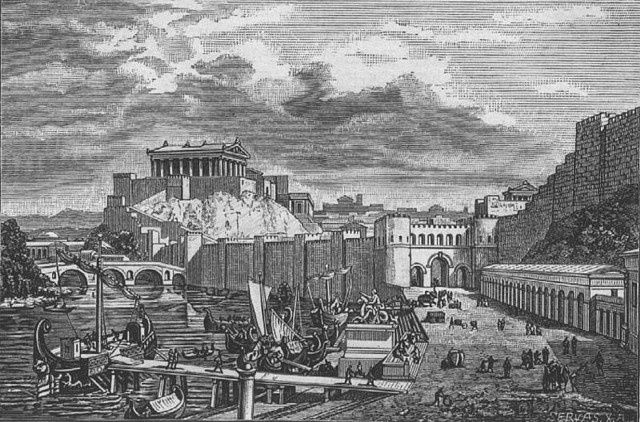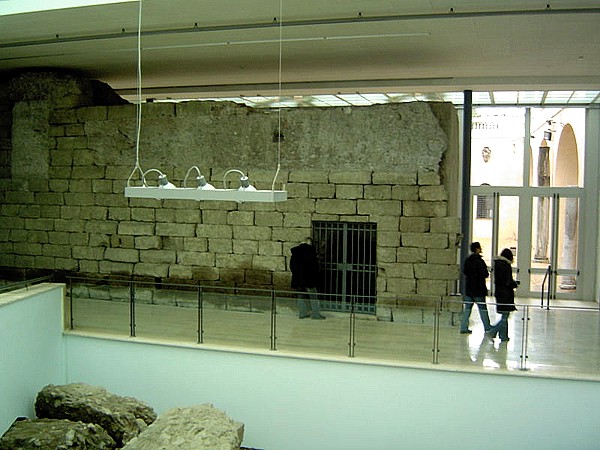Lessico
Termine / Termino
In latino Terminus. Dio romano personificante la definizione dei termini spaziali e temporali: era il dio che traeva il nome dalla “pietra confinaria” (terminus) e dava il nome all'ultimo giorno dell'anno del calendario arcaico. Termino rappresentava per i Romani la stabilità cosmica – si potrebbe dire la stessa stabilità della pietra rispetto alle specie viventi – posta tuttavia non come una realtà assoluta (statica), bensì come elemento dialettico per l'espressione di una realtà in fieri (dinamica), non contenibile da alcun “confine” ma “infinita” o aperta a ogni possibilità: il tipo di realtà presupposto dalla cultura romana e che è certamente a fondamento dell'espansionismo di Roma.
Da ciò deriva la scarsa
importanza di un dio quale Termino (in funzione del “terminare”), rispetto
a uno degli dei più importanti del culto pubblico, Giano, connesso con la
funzione opposta (quella dell'“iniziare”). Di fatto l'azione
“iniziante” di Giano non è moderata dall'azione “terminante” di
Termino, bensì dall'azione “ordinante” di Giove![]() , il sovrano degli dei.
Nella contrapposizione a Giano, Giove sembra subentrare a Termino, così come,
per la tradizione, il tempio di Giove sul Campidoglio è subentrato a un
preesistente santuario di Termino.
, il sovrano degli dei.
Nella contrapposizione a Giano, Giove sembra subentrare a Termino, così come,
per la tradizione, il tempio di Giove sul Campidoglio è subentrato a un
preesistente santuario di Termino.
E, d'altra parte, Termino diventa talvolta un epiteto dello stesso Giove (Iupiter Terminus), a significare che la “definizione” del mondo per i Romani non poteva configurarsi come una “limitazione”; poteva invece essere intesa come un “ordinamento” realizzabile nella storia sia pure in conformità della volontà di Giove. Così si spiega la scarsa importanza di Termino nel culto pubblico. Non altrettanto accadeva nel culto privato, dove si riconosceva a Termino la funzione di difendere la proprietà terriera, mediante la presenza di confini inamovibili. In suo onore il 23 febbraio si celebravano le feste dette Terminalia.
Enciclopedia De Agostini

Il Campidoglio in epoca repubblicana
Termine
Termine (lat. Terminus) è un epiteto di Giove, come protettore di ogni diritto e di ogni impegno. Divenne in seguito divinità indipendente che vegliava sui confini dei poderi e sulle pietre terminali. Aveva una cappella che si innalzava all' interno del Tempio di Giove Ottimo Massimo sul Campidoglio.

Resti del tempio di Giove sul Campidoglio
Si raccontava che durante la costruzione del tempio le numerose divinità delle cappelle che si trovavano sul luogo scelto, accettarono di ritirarsi, per lasciare il posto al signore degli Dei.
Solamente il dio Termine si rifiutò di partire, e si dovette includere la sua cappella all'interno del tempio. Dato però che la sua effigie doveva ergersi sotto il cielo, fu praticata una apertura sul tetto del tempio a suo uso esclusivo in modo che il dio potesse estendere il suo potere all'Universo.
Plutarco![]() ci tramanda che Termine era
l’unica divinità romana che rifiutava i sacrifici cruenti e accettava in
dono solo foglie e petali di fiori per ornare i suoi simulacri. Il 23
febbraio, ultimo mese dell'anno nell'antico calendario, si celebravano le Terminalia,
festa dei termini, cioè delle pietre terminali, su cui si ponevano una corona
e una focaccia offerta al dio.
ci tramanda che Termine era
l’unica divinità romana che rifiutava i sacrifici cruenti e accettava in
dono solo foglie e petali di fiori per ornare i suoi simulacri. Il 23
febbraio, ultimo mese dell'anno nell'antico calendario, si celebravano le Terminalia,
festa dei termini, cioè delle pietre terminali, su cui si ponevano una corona
e una focaccia offerta al dio.
In Roman religion, Terminus was the god who protected boundary markers; his name was the Latin word for such a marker. Sacrifices were performed to sanctify each boundary stone, and landowners celebrated a festival called the Terminalia in Terminus' honor each year on February 23. The Temple of Jupiter Optimus Maximus on the Capitoline Hill was thought to have been built over a shrine to Terminus, and he was occasionally identified as an aspect of Jupiter under the name Jupiter Terminalis.
Ancient writers believed that the worship of Terminus had been introduced to Rome during the reign of the first king Romulus (traditionally 753–717 BC) or his successor Numa (717–673 BC). Modern scholars have variously seen it as the survival of an early animistic reverence for the power inherent in the boundary marker, or as the Roman development of proto-Indo-European belief in a god concerned with the division of property.
Worship
The name of the god Terminus was the Latin word for a boundary stone, and his worship as recorded in the late Republic and Empire centred on this stone, with which the god could be identified. Siculus Flaccus, a writer on land surveying, records the ritual by which the stone was sanctified: the bones, ashes and blood of a sacrificial victim, along with crops, honeycombs and wine, were placed into a hole at a point where estates converged, and the stone was driven in on top. On February 23 annually, a festival called the Terminalia was celebrated in Terminus' honor, involving practices which can be regarded as a reflection or "yearly renewal" of this foundational ritual. Neighboring families would garland their respective sides of the marker and make offerings to Terminus at an altar – Ovid identifies these, again, as crops, honeycombs and wine. The marker itself would be drenched in the blood of a sacrificed lamb or pig. There followed a communal feast and hymns in praise of Terminus.
These rites were practised by private landowners, but there were also related public ceremonies. Ovid refers to the sacrifice of a sheep on the day of the Terminalia at the sixth milestone from Rome along the Via Laurentina; it is likely this was thought to have marked the boundary between the early Romans and their neighbors in Laurentum (near Tor Paterno, 25 km south of Rome). Also, a stone or altar of Terminus was located in the Temple of Jupiter Optimus Maximus on Rome's Capitoline Hill. Because of a belief that this stone had to be exposed to the sky, there was a small hole in the ceiling directly above it. On occasion Terminus' association with Jupiter extended to regarding Terminus as an aspect of that god; Dionysius of Halicarnassus refers to "Jupiter Terminalis", and one inscription names a god "Juppiter Ter."
There is some evidence that Terminus' associations could extend from property boundaries to limits more generally. Under the Republican calendar, when the intercalary month Mercedonius was added to a year, it was placed after February 23 or February 24, and some ancient writers believed that the Terminalia on February 23 had once been the end of the year. Diocletian's decision in 303 AD to initiate his persecution of Christians on February 23 has been seen as an attempt at enlisting Terminus "to put a limit to the progress of Christianity".
History
Ancient views
Ancient authors agreed that the worship of Terminus was of Sabine origin, ascribing its introduction to Rome either to Titus Tatius, the Sabine colleague of Rome's founding king Romulus (traditional reign 753–717 BC), or to Romulus' successor Numa Pompilius (717–673 BC). Those authors who gave the credit to Numa explained his motivation as the prevention of violent disputes over property. Plutarch further states that, in keeping with Terminus's character as a guarantor of peace, his earliest worship did not involve blood sacrifices.
The stone in the Capitoline Temple was believed to have been among the altars located on the Capitoline Hill before the Temple was built under Tarquinius Priscus (traditional reign 616–579 BC) or Tarquinius Superbus (535–510 BC). When the augurs took the auspices to discover whether each the god or goddess of each altar was content for it to be moved, Terminus refused permission, either alone or along with Juventas the goddess of youth. The stone was therefore included within the Capitoline Temple, and its immovability was regarded as a good omen for the permanence of the city's boundaries.
Modern views
According to the dominant scholarly view during the late 19th and much of the 20th century, Roman religion was originally animistic, directed towards spirits associated with specific objects or activities which were only later perceived as gods with independent personal existence. Terminus, with his lack of mythology and his close association with a physical object, seemed a clear example of a deity who had developed little from such a stage.
This view of Terminus retains some recent adherents, but other scholars have argued from Indo-European parallels that the personalised gods of Roman religion must have preceded the city's foundation. Georges Dumézil regarded Jupiter, Juventas and Terminus as the Roman form of a proto-Indo-European triad, comparing the Roman deities respectively to the Vedic Mitra, Aryaman and Bhaga. In this view the sovereign god (Jupiter/Mitra) was associated with two minor deities, one concerned with the entry of men into society (Juventas/Aryaman) and the other with the fair division of their goods (Terminus/Bhaga).